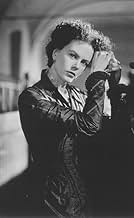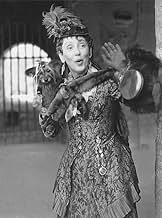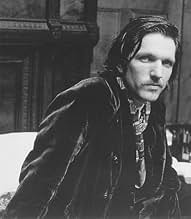VALUTAZIONE IMDb
6,2/10
12.908
LA TUA VALUTAZIONE
Una ragazza americana eredita una fortuna e finisce in una relazione sbagliata con un finto gentiluomo la cui vera natura, inclusa un'indole spinata e avida, trasforma la sua vita in un incu... Leggi tuttoUna ragazza americana eredita una fortuna e finisce in una relazione sbagliata con un finto gentiluomo la cui vera natura, inclusa un'indole spinata e avida, trasforma la sua vita in un incubo.Una ragazza americana eredita una fortuna e finisce in una relazione sbagliata con un finto gentiluomo la cui vera natura, inclusa un'indole spinata e avida, trasforma la sua vita in un incubo.
- Candidato a 2 Oscar
- 5 vittorie e 15 candidature totali
Amy Lindsay
- Miss Molyneux #1
- (as Katie Campbell)
Trama
Lo sapevi?
- QuizFirst collaboration between director Dame Jane Campion and Nicole Kidman. However, it was Campion who discovered Kidman, where she, at the age of fourteen, was performing at Australian Theater for Young People and subsequently caught the eye of Campion.
- Blooper(at around 47 mins) A horse carriage is passing through the shot from right to left. The crew with dolly-cam and equipment is clearly visible.
- Citazioni
Ralph Touchett: I love you but without hope.
- Curiosità sui creditiJane Campion thanks her family, Colin, Alice and Richard, for their generous support, suggestions and encouragement during the making of this film.
- Colonne sonoreImpromptu in A Flat Major, Op 90 No. 4, D899
(1828)
Composed by Franz Schubert
Adapted for screen by Brian Lock
Performed by Jean-Yves Thibaudet (as Jean Yves Thibaudet)
Courtesy of Decca Records Company Ltd.
Recensione in evidenza
Henry James has never struck me as being the most cinematic of authors; his novels generally involve detailed explorations of the psychology of his characters and are marked by a highly elaborate prose style, characterised by lengthy, complex sentences and Latinate vocabulary. Yet a number of films have been based on his works, some of them very successful, dating back to "The Lost Moment" (based on "The Aspern Papers") and "The Heiress" (based on "Washington Square") in the late forties. The Merchant-Ivory team made three film adaptations of his novels, "The Europeans", "The Bostonians" and "The Golden Bowl".
Like many of James's novels, "The Portrait of a Lady" is set among American expatriates in Europe. The central character, Isabel Archer, is a young American woman who becomes financially independent after she inherits a large amount of money from her English uncle Mr Touchett. While travelling on the Continent she meets another American expatriate, Gilbert Osmond, in Florence. The two marry, but the marriage is not a happy one, and Isabel comes to suspect that Osmond is a fortune-hunter whose only interest in her is financial.
The film is made in the "heritage cinema" style, popular in the eighties and nineties, and is reminiscent of the work of Merchant-Ivory and of certain other films of the period, such as Martin Scorsese's "The Age of Innocence" and Terence Davies's "The House of Mirth". Films in this style are generally set in the nineteenth or early twentieth century among the well-to-do classes, are generally based upon a literary source and are characterised by a detailed recreation of the look of the period and by an emphasis on dialogue and character development rather than physical action.
Nicole Kidman's acting career got off to a promising start with films like "Dead Calm" and "Flirting", but over the next ten years or so she seemed to get stuck in something of a rut, appearing in far too many dull or second-rate films like "Far and Away", "Batman Forever", "Practical Magic" and the dreadful "Moulin Rouge". "The Portrait of a Lady" is considerably better than any of those films, but Kidman's performance is not her best, and her accent is not always reliable. It has become commonplace to describe American actors unsuccessfully attempting a British accent (or vice-versa) as being stuck in mid- Atlantic. Kidman's Aussie-tinged American accent is probably the first example of a major stat being linguistically stuck in mid-Pacific.
John Malkovich is a lot better; like his Valmont in another period drama, "Dangerous Liaisons" his Osmond is the sort of character he excels at playing, able to combine an icy reptilian coldness with a certain smooth and plausible charm. There are also good contributions from Barbara Hershey as Osmond's friend and co-conspirator Madame Merle and from John Gielgud in a cameo as the elderly Touchett. (Gielgud was 92 at the time, and this was far from being his last film; he was to continue working up until his death in 2000 at the age of 96).
Although Henry James was a dramatist as well as a novelist, and adapted several of his books for the stage, he considered "The Portrait of a Lady" to be unsuitable for dramatic presentation and dissuaded a friend who wanted to turn it into a play. That, however, did not dissuade Jane Campion from attempting to film the novel. Having recently watched the film for the first time since seeing it in the cinema in 1996, I can say that, in my view, James was probably right. It is, like many examples of "heritage cinema", visually attractive, but it is also rather emotionally cold and too slow-moving. There is nothing much about it which remains in the mind for long afterwards. It does not really compare with the greatest heritage movies like "The Age of Innocence", "The House of Mirth" or the best examples of Merchant-Ivory's work such as "Howard's End". Or, for that matter, with Jane Campion's own earlier, more dramatic and passionate period drama, "The Piano". 6/10
Like many of James's novels, "The Portrait of a Lady" is set among American expatriates in Europe. The central character, Isabel Archer, is a young American woman who becomes financially independent after she inherits a large amount of money from her English uncle Mr Touchett. While travelling on the Continent she meets another American expatriate, Gilbert Osmond, in Florence. The two marry, but the marriage is not a happy one, and Isabel comes to suspect that Osmond is a fortune-hunter whose only interest in her is financial.
The film is made in the "heritage cinema" style, popular in the eighties and nineties, and is reminiscent of the work of Merchant-Ivory and of certain other films of the period, such as Martin Scorsese's "The Age of Innocence" and Terence Davies's "The House of Mirth". Films in this style are generally set in the nineteenth or early twentieth century among the well-to-do classes, are generally based upon a literary source and are characterised by a detailed recreation of the look of the period and by an emphasis on dialogue and character development rather than physical action.
Nicole Kidman's acting career got off to a promising start with films like "Dead Calm" and "Flirting", but over the next ten years or so she seemed to get stuck in something of a rut, appearing in far too many dull or second-rate films like "Far and Away", "Batman Forever", "Practical Magic" and the dreadful "Moulin Rouge". "The Portrait of a Lady" is considerably better than any of those films, but Kidman's performance is not her best, and her accent is not always reliable. It has become commonplace to describe American actors unsuccessfully attempting a British accent (or vice-versa) as being stuck in mid- Atlantic. Kidman's Aussie-tinged American accent is probably the first example of a major stat being linguistically stuck in mid-Pacific.
John Malkovich is a lot better; like his Valmont in another period drama, "Dangerous Liaisons" his Osmond is the sort of character he excels at playing, able to combine an icy reptilian coldness with a certain smooth and plausible charm. There are also good contributions from Barbara Hershey as Osmond's friend and co-conspirator Madame Merle and from John Gielgud in a cameo as the elderly Touchett. (Gielgud was 92 at the time, and this was far from being his last film; he was to continue working up until his death in 2000 at the age of 96).
Although Henry James was a dramatist as well as a novelist, and adapted several of his books for the stage, he considered "The Portrait of a Lady" to be unsuitable for dramatic presentation and dissuaded a friend who wanted to turn it into a play. That, however, did not dissuade Jane Campion from attempting to film the novel. Having recently watched the film for the first time since seeing it in the cinema in 1996, I can say that, in my view, James was probably right. It is, like many examples of "heritage cinema", visually attractive, but it is also rather emotionally cold and too slow-moving. There is nothing much about it which remains in the mind for long afterwards. It does not really compare with the greatest heritage movies like "The Age of Innocence", "The House of Mirth" or the best examples of Merchant-Ivory's work such as "Howard's End". Or, for that matter, with Jane Campion's own earlier, more dramatic and passionate period drama, "The Piano". 6/10
- JamesHitchcock
- 6 dic 2012
- Permalink
I più visti
Accedi per valutare e creare un elenco di titoli salvati per ottenere consigli personalizzati
- How long is The Portrait of a Lady?Powered by Alexa
Dettagli
- Data di uscita
- Paesi di origine
- Lingue
- Celebre anche come
- The Portrait of a Lady
- Luoghi delle riprese
- Palazzo Pfanner, Lucca, Tuscany, Italia(Osmond's palace in Florence)
- Aziende produttrici
- Vedi altri crediti dell’azienda su IMDbPro
Botteghino
- Lordo Stati Uniti e Canada
- 3.692.836 USD
- Fine settimana di apertura Stati Uniti e Canada
- 107.819 USD
- 29 dic 1996
- Lordo in tutto il mondo
- 3.692.836 USD
- Tempo di esecuzione2 ore 24 minuti
- Colore
- Mix di suoni
- Proporzioni
- 2.35 : 1
Contribuisci a questa pagina
Suggerisci una modifica o aggiungi i contenuti mancanti

Divario superiore
By what name was Ritratto di signora (1996) officially released in India in English?
Rispondi



































